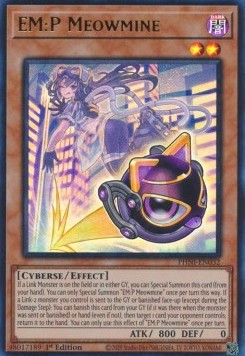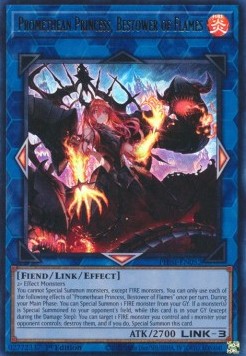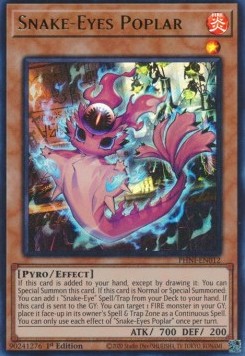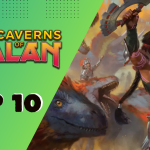The 10 Cards Everybody Wants From Phantom Nightmare

The release of Core Booster sets can sometimes catch us by surprise, and Phantom Nightmare has done just that. The anticipation for this set has been prolonged, especially with the promise of new legacy support for Yubel and the impending meta-defining Snake-Eyes Poplar.
It’s true; I’ll admit I have a soft spot for certain strategies that might not be widely popular. However, when it comes to new legacy support, that’s always a welcome addition in my household. Phantom Nightmare has not disappointed, offering a plethora of Quarter Century Secret Rares and support for enjoyable strategies like Gate Guardian, Earthbound, and Ghoti. While there are numerous cards to explore, I’ve narrowed it down to 10 standout cards that I believe will resonate with many enthusiasts, and those are the ones I want to spotlight today!
The extended wait for these cards, even after the initial announcement of legacy support for Yubel, has created a feeling of impatience among fans. The anticipation has only heightened with each new announcement, especially for those, like the author and a handful of others, who have a particular fondness for the White Aura cards. The excitement for these specific releases has turned the wait into an agonizing experience, underscoring the eagerness of the community to get their hands on these new additions to the game.
#10 Veidos The Eruption Dragon Of Extinction
The sight of an effect that special summons a monster to your opponent’s side of the field never fails to induce a sense of panic in me. Summon Sorceress and Grinder Golem, both notorious for being degenerate combo enablers, inadvertently caused a host of issues by granting your opponent a monster. This seemingly innocuous mechanic has proven to be strangely broken, acting as a gateway for some truly unruly combos that can spiral out of control.

Ashened finds itself in a peculiar position during its debut release due to the limited number of cards associated with it. Veidos stands out as the essential and central component of the deck, playing a pivotal role. However, the strategy itself diverges from the conventional approach observed in the majority of modern decks, which often excel in prolonged combo setups, creating unbreakable boards over extended periods. The uniqueness of the Ashened strategy lies in its departure from the prevalent trend in modern deck-building.
Even though Veidos isn’t explicitly labeled as an «Ashened» monster, it has emerged as arguably the most sought-after card within the «Ashened» lineup. The strategy may appear somewhat disjointed, lacking a strong cohesion, but it’s crucial not to underestimate any World Premiere theme. There’s always a considerable chance that powerful support may be introduced later, potentially elevating the theme’s effectiveness.
Cards like Veidos draw parallels to Spellbook of Secrets: being integral to the deck, it’s advisable to secure them sooner rather than later to stay ahead of potential price increases. This holds true even if the initial wave of support doesn’t immediately position the theme as a top contender.
#9 Yubel - The Loving Defender Forever
The introduction of more Yubel support is undoubtedly a cause for celebration among Yubel players. However, for those not well-versed in the intricacies of Yubel strategies, the immediate reaction might be one of confusion: what exactly does this new support do?
The text suggests a potentially complex or unique effect that may require a closer examination or explanation for players unfamiliar with the nuances of Yubel gameplay.
The original Yubel line, featuring cards like Yubel – Terror Incarnate and Yubel – the Ultimate Nightmare, had a thematic focus on inflicting burn damage to your opponent after engaging in battles with their monsters.

In essence, your Yubel monsters would endure a battle, subsequently dealing significant burn damage to your opponent. Following the battle, these monsters would then self-destruct. While this strategy was wickedly inconsistent and hinged on the unpredictable Battle Phase, it aligned with the volatile nature of the GX era, capturing the essence of that period in the game’s history.
Yubel – The Loving Defender Forever holds its own in Yubel decks, evoking a sense of nostalgia. However, beyond its role within Yubel-themed strategies, this Fusion monster also presents itself as a potentially valuable target for Super Polymerization. With a Yubel monster or an adequate substitute in play, you can absorb all of your opponent’s monsters using a card that they are unable to counter.
This strategic move not only adds versatility to the Yubel deck but also allows for impactful plays against specific threats. As a playful jab, it’s worth noting that this approach is effective against monsters like Guardian Chimera, which, despite community misconceptions, cannot be summoned with Super Polymerization.
#8 Goblin Biker Big Gabonga
The mention of goblin bikers triggers flashbacks to Goblins’ dominance in Magic: The Gathering from years ago. However, these new goblin bikers have no connection to Magic and bear no resemblance to the somewhat pitiful army portrayed in Yu-Gi-Oh cards, such as Goblin Attack Force. The association with Magic’s goblin history adds a layer of nostalgia and contrast to the uniqueness of the current goblin bikers in focus.

The Goblin Bikers make their presence felt on the field through a unique approach, assimilating your opponent’s cards as Xyz Materials. The linchpin of this strategy is Goblin Biker Big Gabonga, serving as the central catalyst. It facilitates the deck by searching for a Goblin Biker monster from your deck. Additionally, Goblin Biker Dugg Charger extends the strategy’s capabilities by retrieving a non-monster Goblin Biker card.
Adding a layer of versatility, Big Gabonga boasts the advantage of being a generic Rank 3 Xyz, making its inclusion a notable factor. This versatility allows for diverse Xyz plays and contributes to the strategy’s overall effectiveness.
#7 Horus The Black Flame Deity
The Horus cards, while having a recognized niche in various decks, truly excel as tools for deck thinning and summoning multiple monsters. Their effects are so efficient that, before you even finish reading them, there’s a high likelihood that you’d have ample time to discard each Horus monster into the graveyard and subsequently mass revive them. This quick and effective utilization of their abilities makes the Horus cards valuable assets for strategies centered around rapid monster deployment and resource management.

Indeed, while the Horus cards shine in terms of utility, boss monsters like Duamutef, Blessing of Horus often find themselves overshadowed. However, the introduction of Horus the Black Flame Deity injects a new layer of strategy into the mix by allowing you to summon a Horus monster directly from your hand. This alteration in approach adds complexity to a deck that was previously straightforward, primarily focused on discarding half your deck into the graveyard.
While summoning the Black Flame Deity may seem resource-intensive, necessitating the discard of cards from both your hand and field, the presence of Walls of the Imperial Tomb introduces consistency and additional draws to offset the costs of these plays. With the ability to summon four other monsters each turn from your graveyard at no additional cost, it’s challenging to find valid complaints given the deck’s overall synergy and strategic depth.
#6 EM:P Meowmine
Determining an absolute favorite card from Phantom Nightmare can be challenging given the abundance of excellent options in the set. However, a strong contender for personal admiration has emerged in the form of cards revolving around I:P Masquerena. Despite being considered criminals by the S-Force lawmen, you’ve developed a fondness for these cards. The affinity you’ve developed for the I:P Masquerena-centered cards highlights the subjective nature of card preferences and showcases the diverse and engaging aspects of the Phantom Nightmare set.

While its appearance may not be particularly intimidating, Meowmine possesses two effects that can significantly disrupt your opponent’s responses with minimal effort. Leveraging the disruptive abilities of I:P Masquerena and S:P Little Knight, Meowmine introduces an additional layer of complexity to your plays, elevating the overall strategy to a new level. Despite its unassuming look, Meowmine proves to be a valuable asset in creating obstacles for your opponent and enhancing the intricacy of your in-game maneuvers.
By banishing Meowmine from the graveyard, you gain the ability to bounce one card your opponent controls back to their hand, given that you meet the seemingly peculiar conditions. However, when considered in the context of Masquerena and Little Knight, who can perform Link climbing and banish themselves, respectively, these conditions begin to make more sense. The effects of Meowmine are evidently designed to synergize with Masquerena and Little Knight, emphasizing the importance of integrating Meowmine into your deck for enhanced combos, particularly with Little Knight, a sought-after and potent card in today’s tournament scene. The synergy adds significant value to your strategies.
#5 Iron Thunder

While not an exact replica, Iron Thunder bears a striking resemblance to a modern version of Solemn Judgment. In the current landscape of the game, monster effects often overshadow their summons, as these effects can activate from various locations such as the hand or graveyard. Consequently, the ability to halt effects anywhere on the field can prove to be more versatile and impactful than merely preventing summons. Iron Thunder’s design reflects the evolving dynamics of the game, where disrupting effects has become as crucial as, if not more critical than, thwarting summoning attempts.
Iron Thunder also boasts the additional advantage of destroying everything in the column where it activates, a somewhat frightening hidden ability. While this bonus might not necessarily cripple many decks or reshape the meta, it draws parallels to the unexpected threat posed by cards like Waking the Dragon. The element of surprise could catch opponents off guard and lead to unexpected victories.
Returning to Thunder’s primary effect of shutting down your opponent, it seems poised to find a place in any metagame where Solemn Judgment doesn’t align with current tournament trends. Only time will reveal its true impact, but such shifts are an inherent part of the game’s cyclical nature. At some point, Iron Thunder could emerge as a formidable force in the evolving landscape of competitive play.
#4 Majespecter Orthrus - Nue
Among the new cards that Majespecters could receive, this one stands out as arguably the most beneficial. Simultaneously, it maintains a balanced design that addresses the inherent drawback of original Majespecters – the lack of effects while in the Pendulum Zone.
It’s reasonable to categorize Pendulum Monsters as potentially unfair on a design level, as their presence introduces a delicate balance in card design. However, providing a theme-specific method for accumulating resources for Pendulum Summons without overly saturating the effects is a positive step forward. This card is poised to make an impact, but one that contributes positively to the game without causing imbalance or unhealthy interactions.
Certainly, over time, there might be a few broken combos, but balancing Majespecters has always presented a challenge given their established pattern: no effect as a Pendulum scale, coupled with a free «get a card from your deck» ability upon summoning.

While this concept may have been considered potent from the outset, Majespecter Orthrus – Nue undeniably propels Majespecters into the modern era. For enthusiasts of adorable monsters, this evolution is undoubtedly a commendable idea that breathes new life into the Majespecter archetype.
#3 Promethean Princess, Bestower Of Flames
The fiery intensity of Fire decks has recently reached new heights, and Snake-Eyes strategies have played a significant role in stoking these flames.

The initial effect of Promethean Princess, Bestower of Flames is undeniably exceptional – who wouldn’t welcome free monsters? Fire Kings and Salamangreats stand out as some of my preferred choices, although Rescue-ACE, Battlin’ Boxers, Infernoble Knights, and even the new Flame Swordsman cards can all leverage this Link.
Despite the narrower options in the second list of cards, the remarkable second effect deserves emphasis. By sacrificing a spare monster, Promethean Princess transforms into a shrapnel bomb, eliminating one of your opponent’s monsters while making a resilient return from the graveyard. It’s an astounding capability with undeniable appeal. Moreover, with ongoing support for Fire attributes, this card is poised to enhance its prowess further as more Fire-themed cards are introduced.
#2 Lo, The Prayers Of The Voiceless Voice
The introduction of this card undoubtedly raises expectations for the viability of Ritual Monsters.
Indeed, Lo, the Prayers of the Voiceless Voice significantly improves the cost-effectiveness and efficiency of certain Ritual monsters, and the card doesn’t come with any notable downsides. While some might perceive its limitation to Light Warrior and Dragon Ritual Monsters as restrictive, it’s akin to considering Fire Formation – Tenki restrictive – a sentiment hardly expressed by anyone given the vast array of options in a card pool of over eleven thousand in Yu-Gi-Oh today. The potential choices available make this limitation more of a negligible factor.
A particularly enjoyable synergy with this card is Ritual Sanctuary. Remarkably, Sanctuary’s utility has diminished over time. Even Diviner of the Herald was considered too cumbersome for pairing with Ritual Sanctuary due to its Level 2 status. However, with this powerful Level 1 option for Ritual decks, numerous two-card combos that would typically demand extensive setup become achievable.

#1 Snake-Eyes Poplar
This card undeniably exhibits incredible strength on its own. Rather than delving into niche plays, it’s worth noting that Snake-Eyes Poplar opens the door for one-card combos, making it a valuable addition to some of the strongest decks in modern Yu-Gi-Oh. Why bother crafting alternative strategies when such a versatile card simplifies the process with ease?

Certainly, here’s a breakdown of the combo:
1. Start by Normal Summoning Snake-Eye Ash, using its effect to search Poplar and Special Summon it. Additionally, search for Original Sinful Spoils – Snake-Eye.
2. Utilize Snake-Eye Ash to send both monsters to the graveyard, bringing Snake-Eye Oak directly from your deck. This triggers Oak’s effect, allowing it to summon back Ash and place Poplar as a face-up spell.
3. Activate Oak’s effect to send both Oak and Poplar to the graveyard, enabling the summoning of a powerful monster such as Snake-Eyes Flamberge Dragon.
In conclusion, the Snake-Eyes Poplar stands out as a pivotal card in Phantom Nightmare, offering a straightforward yet potent combo that can significantly disrupt opponents. Its ability to facilitate simple 1-card combos, especially in a deck filled with tech cards, makes it a highly sought-after and impactful addition. As the Yu-Gi-Oh! landscape evolves, Snake-Eyes Poplar is poised to play a central role in dominant strategies, making it a standout choice for players seeking competitive success in the Phantom Nightmare era.



